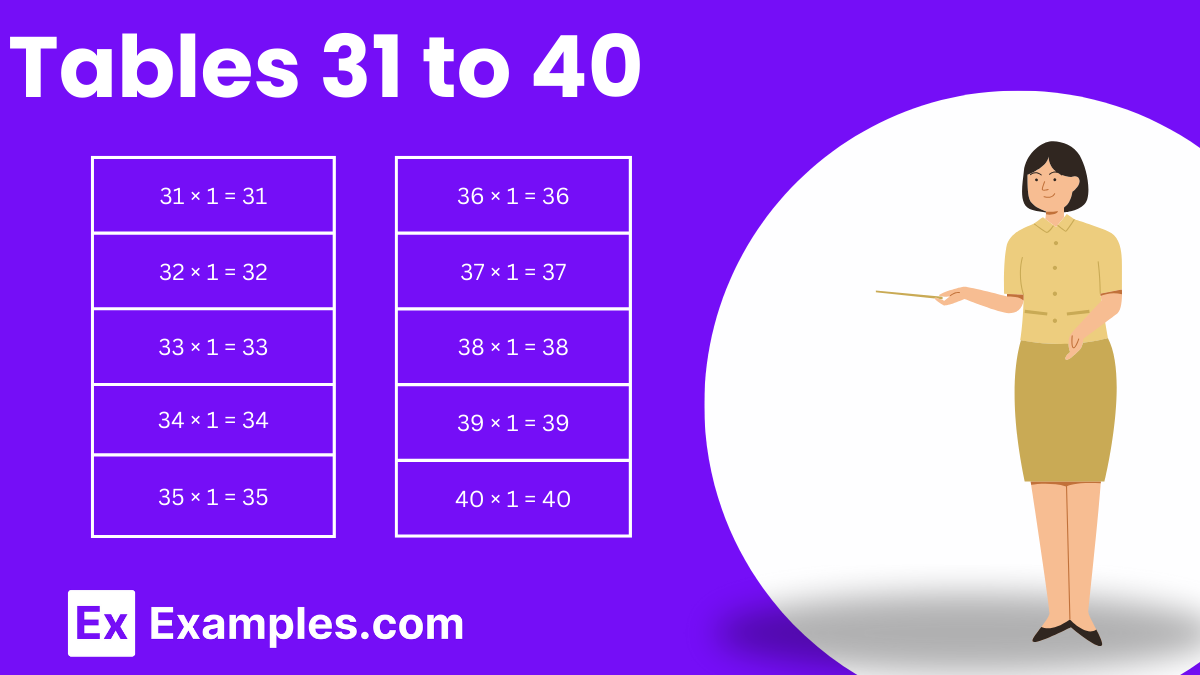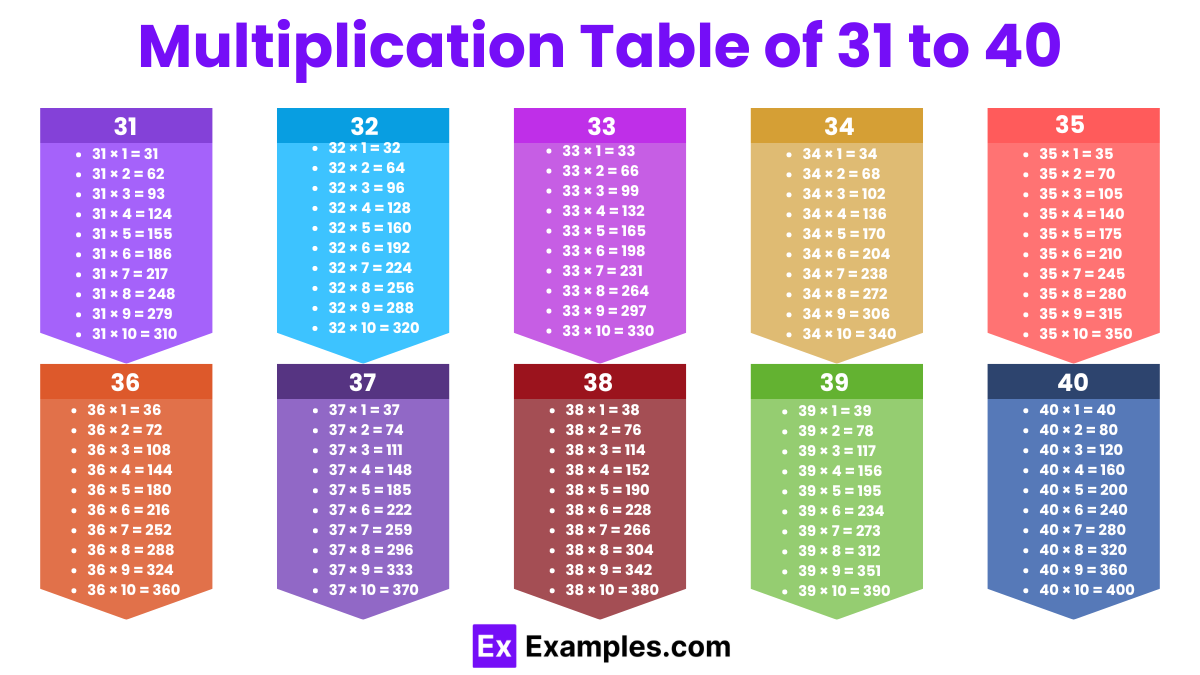What is 34 multiplied by 7?
230
234
238
242


Multiplication tables from 31 to 40 encompass a range of products that are essential for advanced mathematical calculations and practical applications. Learning these tables enhances the ability to quickly perform multiplications that are crucial in fields such as engineering, computer science, and finance. Mastering these tables not only aids in academic pursuits but also simplifies complex calculations in daily life and professional settings.

Download Tables From 31 to 40 Chart Pdf
These tables extend beyond the basic multiplication facts commonly taught in early education, providing a foundation for more complex arithmetic operations and problem-solving skills. A chart for tables 31 to 40 is particularly useful for students in upper elementary and middle school, as it prepares them for higher-level math concepts and exams.
Download Tables From 31 to 40 Chart Pdf
| 31 Table | 32 Table | 33 Table | 34 Table | 35 Table |
|---|---|---|---|---|
| 31 × 1 = 31 | 32 × 1 = 32 | 33 × 1 = 33 | 34 × 1 = 34 | 35 × 1 = 35 |
| 31 × 2 = 62 | 32 × 2 = 64 | 33 × 2 = 66 | 34 × 2 = 68 | 35 × 2 = 70 |
| 31 × 3 = 93 | 32 × 3 = 96 | 33 × 3 = 99 | 34 × 3 = 102 | 35 × 3 = 105 |
| 31 × 4 = 124 | 32 × 4 = 128 | 33 × 4 = 132 | 34 × 4 = 136 | 35 × 4 = 140 |
| 31 × 5 = 155 | 32 × 5 = 160 | 33 × 5 = 165 | 34 × 5 = 170 | 35 × 5 = 175 |
| 31 × 6 = 186 | 32 × 6 = 192 | 33 × 6 = 198 | 34 × 6 = 204 | 35 × 6 = 210 |
| 31 × 7 = 217 | 32 × 7 = 224 | 33 × 7 = 231 | 34 × 7 = 238 | 35 × 7 = 245 |
| 31 × 8 = 248 | 32 × 8 = 256 | 33 × 8 = 264 | 34 × 8 = 272 | 35 × 8 = 280 |
| 31 × 9 = 279 | 32 × 9 = 288 | 33 × 9 = 297 | 34 × 9 = 306 | 35 × 9 = 315 |
| 31 × 10 = 310 | 32 × 10 = 320 | 33 × 10 = 330 | 34 × 10 = 340 | 35 × 10 = 350 |
| 36 Table | 37 Table | 38 Table | 39 Table | 40 Table |
|---|---|---|---|---|
| 36 × 1 = 36 | 37 × 1 = 37 | 38 × 1 = 38 | 39 × 1 = 39 | 40 × 1 = 40 |
| 36 × 2 = 72 | 37 × 2 = 74 | 38 × 2 = 76 | 39 × 2 = 78 | 40 × 2 = 80 |
| 36 × 3 = 108 | 37 × 3 = 111 | 38 × 3 = 114 | 39 × 3 = 117 | 40 × 3 = 120 |
| 36 × 4 = 144 | 37 × 4 = 148 | 38 × 4 = 152 | 39 × 4 = 156 | 40 × 4 = 160 |
| 36 × 5 = 180 | 37 × 5 = 185 | 38 × 5 = 190 | 39 × 5 = 195 | 40 × 5 = 200 |
| 36 × 6 = 216 | 37 × 6 = 222 | 38 × 6 = 228 | 39 × 6 = 234 | 40 × 6 = 240 |
| 36 × 7 = 252 | 37 × 7 = 259 | 38 × 7 = 266 | 39 × 7 = 273 | 40 × 7 = 280 |
| 36 × 8 = 288 | 37 × 8 = 296 | 38 × 8 = 304 | 39 × 8 = 312 | 40 × 8 = 320 |
| 36 × 9 = 324 | 37 × 9 = 333 | 38 × 9 = 342 | 39 × 9 = 351 | 40 × 9 = 360 |
| 36 × 10 = 360 | 37 × 10 = 370 | 38 × 10 = 380 | 39 × 10 = 390 | 40 × 10 = 400 |
Example 1: Table of 31
Problem: 31 x 9 = ?
Solution: 31 x 9 = 279 (Thirty-one times nine equals two hundred seventy-nine.)
Example 2: Table of 32
Problem: 32 x 5 = ?
Solution: 32 x 5 = 160 (Thirty-two multiplied by five results in one hundred sixty.)
Example 3: Table of 33
Problem: 33 x 7 = ?
Solution: 33 x 7 = 231 (Thirty-three times seven yields two hundred thirty-one.)
Example 4: Table of 34
Problem: 34 x 8 = ?
Solution: 34 x 8 = 272 (Thirty-four times eight equals two hundred seventy-two.)
Example 5: Table of 35
Problem: 35 x 10 = ?
Solution: 35 x 10 = 350 (Thirty-five multiplied by ten results in three hundred fifty.)
Example 6: Table of 36
Problem: 36 x 6 = ?
Solution: 36 x 6 = 216 (Thirty-six times six equals two hundred sixteen.)
Example 7: Table of 37
Problem: 37 x 4 = ?
Solution: 37 x 4 = 148 (Thirty-seven times four yields one hundred forty-eight.)
Example 8: Table of 38
Problem: 38 x 9 = ?
Solution: 38 x 9 = 342 (Thirty-eight multiplied by nine results in three hundred forty-two.)
Example 9: Table of 39
Problem: 39 x 3 = ?
Solution: 39 x 3 = 117 (Thirty-nine times three equals one hundred seventeen.)
Example 10: Table of 40
Problem: 40 x 7 = ?
Solution: 40 x 7 = 280 (Forty times seven results in two hundred eighty.)
Learning multiplication tables up to 40 is important because it builds a strong foundation for mathematical skills. It enhances mental arithmetic, improves problem-solving abilities, and facilitates quicker calculations in daily life and academic settings.
There are several techniques you can use to memorize these tables more easily, such as identifying patterns, breaking down multiplications, using mnemonic devices, practicing with flashcards, and visualizing multiplication.
Some common patterns include:
The tables of 31 to 40 are used in various real-life situations such as calculating prices, measuring distances, determining quantities in recipes, understanding financial transactions, and solving problems in fields like engineering, science, and technology.
You can help your child by making learning fun through games, providing visual aids, encouraging regular practice, using real-life examples, offering rewards for progress, and being patient and supportive throughout the learning process.
Text prompt
Add Tone
10 Examples of Public speaking
20 Examples of Gas lighting
What is 34 multiplied by 7?
230
234
238
242
Calculate 31 × 93 using breaking down.
275
279
283
287
What is 32 times 11 using addition?
350
352
354
358
Find the result of 35 × 6 using the distributive property.
200
205
210
215
What is the result of 33 × 4 using splitting?
122
124
126
132
Calculate 36 × 12 using the distributive property and breaking down.
420
432
444
456
What is 38 times 2 using repeated addition?
76
78
80
82
Find 39 × 15 using the doubling and adding method.
570
585
590
600
Calculate 37 × 5 using repeated addition.
180
185
190
195
Find the result of 38 × 17 using breaking down.
636
646
656
666
Before you leave, take our quick quiz to enhance your learning!

